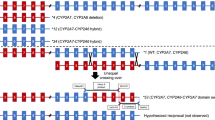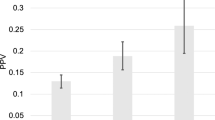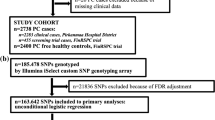Abstract
Genes involved in the testosterone biosynthetic pathway – such as CYP17A1, CYP3A4, and SRD5A2 – represent strong candidates for affecting prostate cancer. Previous work has detected associations between individual variants in these three genes and prostate cancer risk and aggressiveness. To more comprehensively evaluate CYP17A1, CYP3A4, and SRD5A2, we undertook a two-phase study of the relationship between their genotypes/haplotypes and prostate cancer. Phase I of the study first searched for single-nucleotide polymorphisms (SNPs) in these genes by resequencing 24 individuals from the Coriell Polymorphism Discovery Resource, 92–110 men from prostate cancer case–control sibships, and by leveraging public databases. In all, 87 SNPs were discovered and genotyped in 276 men from case–control sibships. Those SNPs exhibiting preliminary case–control allele frequency differences, or distinguishing (ie, ‘tagging’) common haplotypes across the genes, were identified for further study (24 SNPs in total). In Phase II of the study, the 24 SNPs were genotyped in an additional 841 men from case–control sibships. Finally, associations between genotypes/haplotypes in CYP17A1, CYP3A4, and SRD5A2 and prostate cancer were evaluated in the total case–control sample of 1117 brothers from 506 sibships. Family-based analyses detected associations between prostate cancer risk or aggressiveness and a number of CYP3A4 SNPs (P-values between 0.006 and 0.05), a CYP3A4 haplotype (P-values 0.05 and 0.009 in nonstratified and stratified analysis, respectively), and two SRD5A2 SNPs in strong linkage disequilibrium (P=0.02). Undertaking a two-phase study comprising SNP discovery, haplotype tagging, and association analyses allowed us to more fully decipher the relation between CYP17A1, CYP3A4, and SRD5A2 and prostate cancer.
Similar content being viewed by others
Log in or create a free account to read this content
Gain free access to this article, as well as selected content from this journal and more on nature.com
or
References
Smith DS, Bullock AD, Catalona WJ, Herschman JD : Racial differences in a prostate cancer screening study. J Urol 1996; 156: 1366–1369.
Hsing AW, Tsao L, Devesa SS : International trends and patterns of prostate cancer incidence and mortality. Int J Cancer 2000; 85: 60–67.
McLellan DL, Norman RW : Hereditary aspects of prostate cancer. CMAJ 1995; 153: 895–900.
Neville PJ, Casey G, Witte JS : Hereditary prostate cancer and genetic risk; in Klein (ed): Management of Prostate Cancer. New Jersey: Humana Press, Inc., 2003, 2nd edn.
Tavtigian SV, Simard J, Teng DH et al: A candidate prostate cancer susceptibility gene at chromosome 17p. Nat Genet 2001; 27: 172–180.
Rebbeck TR, Walker AH, Zeigler-Johnson C et al: Association of HPC2/ELAC2 genotypes and prostate cancer. Am J Hum Genet 2000; 67: 1014–1019.
Suarez BK, Gerhard DS, Lin J et al: Polymorphisms in the prostate cancer susceptibility gene HPC2/ELAC2 in multiplex families and healthy controls. Cancer Res 2001; 61: 4982–4984.
Rokman A, Ikonen T, Mononen N et al: ELAC2/HPC2 involvement in hereditary and sporadic prostate cancer. Cancer Res 2001; 61: 6038–6041.
Vesprini D, Nam RK, Trachtenberg J et al: HPC2 variants and screen-detected prostate cancer. Am J Hum Genet 2001; 68: 912–917.
Wang L, McDonnell SK, Elkins DA et al: Role of HPC2/ELAC2 in hereditary prostate cancer. Cancer Res 2001; 61: 6494–6499.
Xu J, Zheng SL, Carpten JD et al: Evaluation of linkage and association of HPC2/ELAC2 in patients with familial or sporadic prostate cancer. Am J Hum Genet 2001; 68: 901–911.
Carpten J, Nupponen N, Isaacs S et al: Germline mutations in the ribonuclease L gene in families showing linkage with HPC1. Nat Genet 2002; 30: 181–184.
Casey G, Neville PJ, Plummer SJ et al: RNASEL Arg462Gln variant is implicated in up to 13% of prostate cancer cases. Nat Genet 2002; 32: 581–583.
Rokman A, Ikonen T, Seppala EH et al: Germline alterations of the RNASEL gene, a candidate HPC1 gene at 1q25, in patients and families with prostate cancer. Am J Hum Genet 2002; 70: 1299–1304.
Wang L, McDonnell SK, Elkins DA et al: Analysis of the RNASEL gene in familial and sporadic prostate cancer. Am J Hum Genet 2002; 71: 116–123.
Colombel M, Olsson CA, Ng PY, Buttyan R : Hormone-regulated apoptosis results from reentry of differentiated prostate cells onto a defective cell cycle. Cancer Res 1992; 52: 4313–4319.
Gupta S, Ahmad N, Mohan RR, Husain MM, Mukhtar H : Prostate cancer chemoprevention by green tea: in vitro and in vivo inhibition of testosterone-mediated induction of ornithine decarboxylase. Cancer Res 1999; 59: 2115–2120.
Carey AH, Waterworth D, Patel K et al: Polycystic ovaries and premature male pattern baldness are associated with one allele of the steroid metabolism gene CYP17. Hum Mol Genet 1994; 3: 1873–1876.
Waxman DJ, Lapenson DP, Aoyama T, Gelboin HV, Gonzalez FJ, Korzekwa K : Steroid hormone hydroxylase specificities of eleven cDNA-expressed human cytochrome P450s. Arch Biochem Biophys 1991; 290: 160–166.
Makridakis N, Ross RK, Pike MC et al: A prevalent missense substitution that modulates activity of prostatic steroid 5alpha-reductase. Cancer Res 1997; 57: 1020–1022.
Rebbeck TR, Jaffe JM, Walker AH, Wein AJ, Malkowicz SB : Modification of clinical presentation of prostate tumors by a novel genetic variant in CYP3A4. J Nat Cancer Inst 1998; 90: 1225–1229.
Lunn RM, Bell DA, Mohler JL, Taylor JA : Prostate cancer risk and polymorphism in 17 hydroxylase (CYP17) and steroid reductase (SRD5A2). Carcinogenetics 1999; 20: 1727–1731.
Makridakis NM, Ross RK, Pike MC et al: Association of missense substitution in SRD5A2 gene with prostate cancer in African-American and Hispanic men in Los Angeles, USA. Lancet 1999; 354: 975–978.
Paris PL, Kupelian PA, Hall JM et al: Association between a CYP3A4 genetic variant and clinical presentation in African-American prostate cancer patients. Cancer Epidemiol Biomarkers Prev 1999; 8: 901–905.
Wadelius M, Andersson AO, Johansson JE, Wadelius C, Rane E : Prostate cancer associated with CYP17 genotype. Pharmacogenetics 1999; 9: 635–639.
Gsur A, Bernhofer G, Hinteregger S et al: A polymorphism in the CYP17 gene is associated with prostate cancer risk. Int J Cancer 2000; 87: 434–437.
Habuchi T, Liqing Z, Suzuki T et al: Increased risk of prostate cancer and benign prostatic hyperplasia associated with a CYP17 gene polymorphism with a gene dosage effect. Cancer Res 2000; 60: 5710–5713.
Jaffe JM, Malkowicz SB, Walker AH et al: Association of SRD5A2 genotype and pathological characteristics of prostate tumors. Cancer Res 2000; 60: 1626–1630.
Kittles RA, Panguluri RK, Chen W et al: CYP17 promoter variant associated with prostate cancer aggressiveness in African Americans. Cancer Epidemiol Biomarkers Prev 2001; 10: 943–947.
Nam RK, Toi A, Vesprini D et al: V89L polymorphism of type-2,5-alpha reductase enzyme gene predicts prostate cancer presence and progression. Urology 2001; 57: 199–204.
Stanford JL, Noonan EA, Iwasaki L et al: A polymorphism in the CYP17 gene and risk of prostate cancer. Cancer Epidemiol Biomarkers Prev 2002; 11: 243–247.
Collins FS, Brooks LD, Chakravarti A : A DNA polymorphism discovery resource for research on human genetic variation. Genome Res 1998; 8: 1229–1231.
Stephens M, Smith NJ, Donnelly P : A new statistical method for haplotype reconstruction from population data. Am J Hum Genet 2001; 68: 978–989.
Breslow NE, Day NE : Statistical methods in cancer research. Vol I – The analysis of case–control studies. IARC Sci Publ 1980; 32: 5–338.
Herman-Giddens M, Wang L, Koch G : Secondary sexual characteristics in boys: estimates from the national health and nutrition examination survey III, 1988–1994. Arch Pediatr Adolescent Med 2001; 155: 1022–1028.
Ross R, Bernstein L, Judd H, Hanisch R, Pike M, Henderson B : Serum testosterone levels in healthy young black and white men. J Natl Cancer Inst 1986; 76: 45–48.
Chang B, Zheng SL, Isaacs SD et al: Linkage and association of CYP17 in hereditary and sporadic prostate cancer. Int J Cancer 2001; 95: 354–359.
Haiman CA, Stampfer MJ, Giovannucci E et al: The relationship between a polymorphism in CYP17 with plasma hormone levels and prostate cancer. Cancer Epidemiol Biomarkers Prev 2001; 10: 743–748.
Ntais C, Polycarpou A, Ioannidis JP : Association of the CYP17 gene polymorphism with the risk of prostate cancer: a meta-analysis. Cancer Epidemiol Biomarkers Prev 2003; 12: 120–126.
Plummer SJ, Conti DV, Paris PL, Curran AP, Casey G, Witte JS : CYP3A4 and CYP3A5 genotypes, haplotypes and risk of prostate cancer. Cancer Epidemiol Biomarkers Prev 2003; 12: 928–932.
Lubin JH, Hartge P : Excluding controls: misapplications in case–control studies. Am J Epidemiol 1984; 120: 791–793.
Poole C : Controls who experienced hypothetical causal intermediates should not be excluded from case–control studies. Am J Epidemiol 1999; 150: 547–551.
Thomas DC, Witte JS : Population stratification: a problem for case–control studies of candidate gene associations? Cancer Epidemiol Biomarkers Prev 2002; 11: 505–512.
Acknowledgements
This study was supported by Amersham plc., and grants from the National Institutes of Health (CA88164, CA94186) and US Department of Defense (DAMD17-98-1-8589). Part of JSW's work reported in this paper was undertaken during the tenure of a Visiting Scientist Award by the International Agency for Research on Cancer. A number of talented individuals from Aeomica (a research initiative of Amersham plc.) helped with this project. We thank Thuymy Phan, Baoha Nguyen, Steven Song, Tan Tran, Karen Tran, David Jenkins, Daniel Lee, Kevin Holden, Sarita Balabhadra, Jennifer Dam, Danielle Hern, Rachel Stogner, Gail Jackman, and Mark Lewis. Wensheng Chen, Yonggang Ji, Robert T Loder Jr, Jorgen Jonsson, Anders Brinne, and Bonnie Thiel greatly helped with informatic aspects of the project. Finally, we thank Sasha Lazetic, Richard Belcinski, Audrey Shuster, Marek Minarik, and David Shen.
Author information
Authors and Affiliations
Corresponding author
Supplementary information
Rights and permissions
About this article
Cite this article
Loukola, A., Chadha, M., Penn, S. et al. Comprehensive evaluation of the association between prostate cancer and genotypes/haplotypes in CYP17A1, CYP3A4, and SRD5A2. Eur J Hum Genet 12, 321–332 (2004). https://doi.org/10.1038/sj.ejhg.5201101
Received:
Revised:
Accepted:
Published:
Issue date:
DOI: https://doi.org/10.1038/sj.ejhg.5201101
Keywords
This article is cited by
-
Cytochrome P450 3A4, 3A5, and 2C8 expression in breast, prostate, lung, endometrial, and ovarian tumors: relevance for resistance to taxanes
Cancer Chemotherapy and Pharmacology (2019)
-
Variants in hormone biosynthesis genes and risk of endometrial cancer
Cancer Causes & Control (2008)
-
Using high-throughput SNP technologies to study cancer
Oncogene (2006)
-
Sibship T2 association tests of complex diseases for tightly linked markers
Human Genomics (2005)



